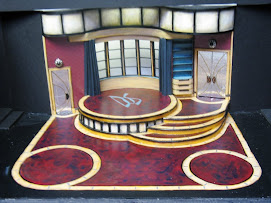Just a small example from the documentary film The Making of Gone with the Wind (searchable on YouTube). At her first wardrobe fitting, the woman playing India Wilkes was astonished at the petticoats -- row upon row of real val lace! She thought she'd do Selznick a favour by telling him that he's wasting a great deal of money on these petticoats that won't even show, that no one will even know is there. Selznick replied, "You'll know it's there. You're the daughter of a rich plantation owner. Now be quiet and stand there and finish getting fitted." Apparently there's a method to his madness.
Here's a quick conversation I had with Gord on how he got into Selznick's head.
A: What kind of work did you do to prepare for this role?
G: I read the book, "Memos from David O. Selznick." It’s not a bio, it’s an accumulation of all of his memos [A: Selznick was an incessant memo-writer to every professional contact he had -- just an insight to his control-freak tendencies]. I watched the movie, Gone With the Wind, and I read a bit of biographical background on Hecht and Fleming. And… well, here’s the thing. I’m not a real believer in that kind of research, normally. I like the idea that essentially everything you need is in the text, and all the decisions can be informed by what is contained therein. But, for something that contains real characters, and the things they actually said, it adds an extra level of enjoyment to the prep. It makes it more fun to know more about the real people. But I don’t think that it’s necessary to create a good play. I think that all of us could have come in knowing nothing about the characters, and could have created something enjoyable for the audience with just the text. It’s not a documentary. It’s a play and it’s fun to "play" if you’re make-believing someone who really lived. That’s my approach. As far as voices go, you've gotta do something that’s a little bit informed by the period and the geographical location, and the societal class of the characters and their backgrounds. But you and I know that so far I haven’t found any recordings of Selznick’s voice.
A: Yeah, I've been looking. I wish I could find something...
G: There's this movie, called Time after Time. Malcolm McDougall plays H.G. Wells in it. I heard that in his prep, McDougall said, "I should find out how he actually sounded." So he found a recording from an archive, and it turned out he had this horrible little voice [A: Gord demonstrates. Think screechy, high-pitched, slightly bird-like...yuck.], and he was a Cockney. So needless to say he decided not to go with that (laughs).
A: So, is there anything new that you've discovered about Selznick since rehearsals began?
G: Throughout this period of his life, he was wacked on Benzedrine. It was all the rage at the time. [A: Benzedrine was first used medicinally as a broncodilator in 1928, but reports of a euphoric stimulant effect quickly made it one of the first recreational drugs-of-choice, and could be taken with coffee or alcohol. Selznick's fixation with popping "bennies" allowed him to work 15-20 hour days on each of his demanding projects, but in the end, shaved years off his life.]
A: Thanks, Gord! Can't wait to see that energy on stage.
----------
It's OPENING NIGHT TONIGHT. See you in the theatre!!



